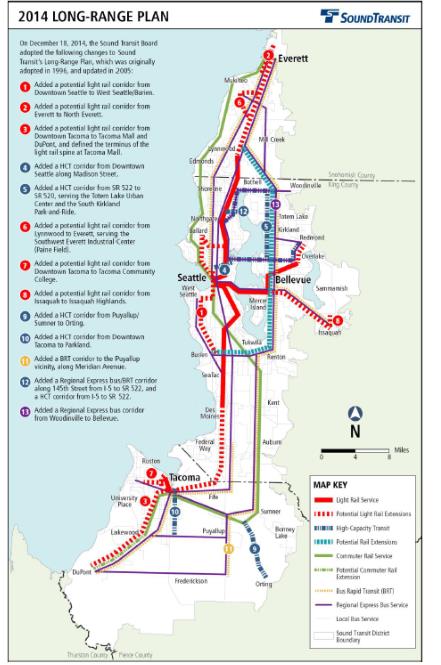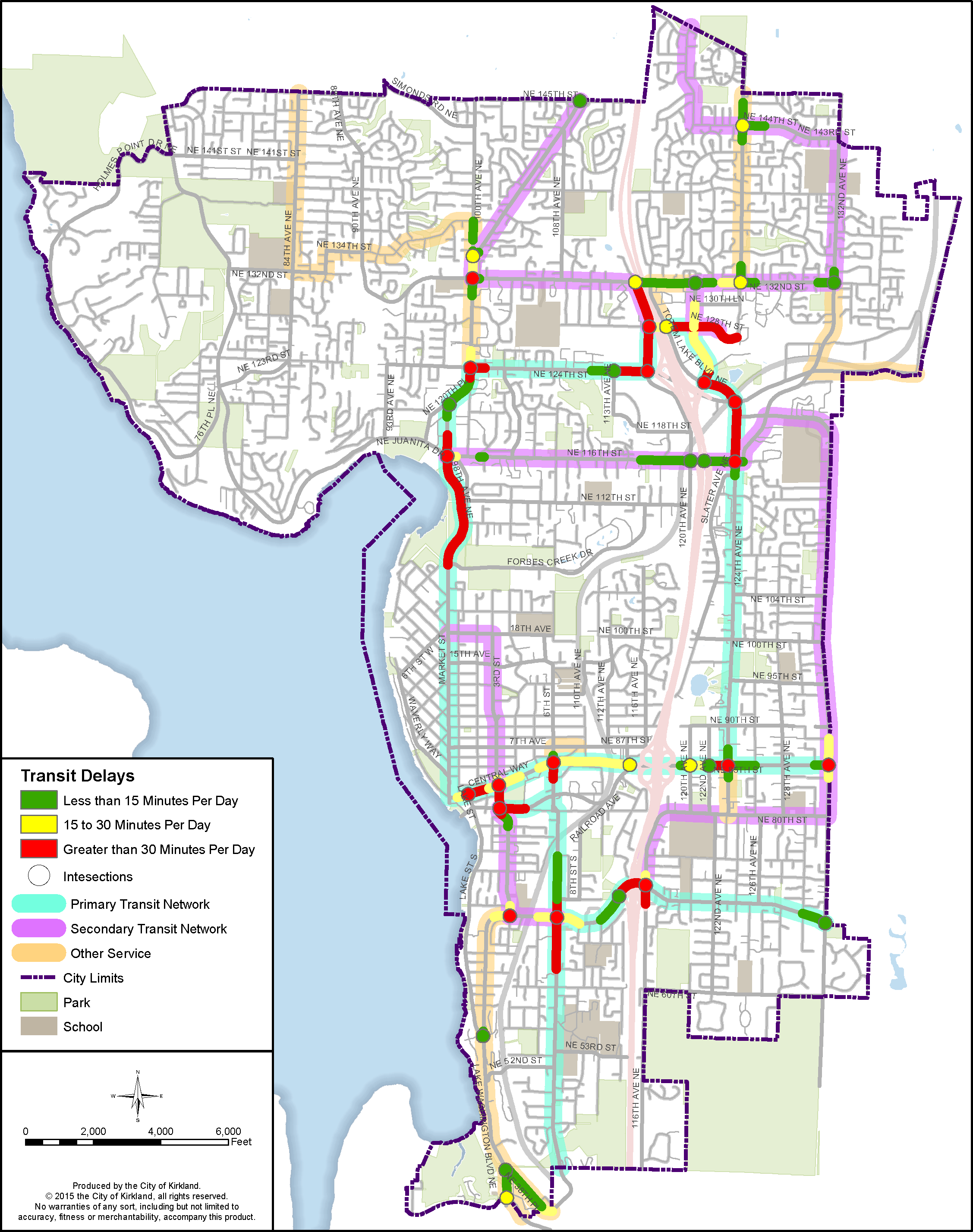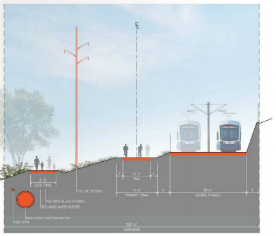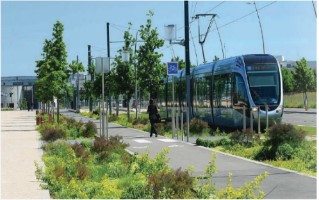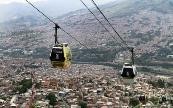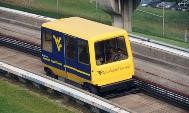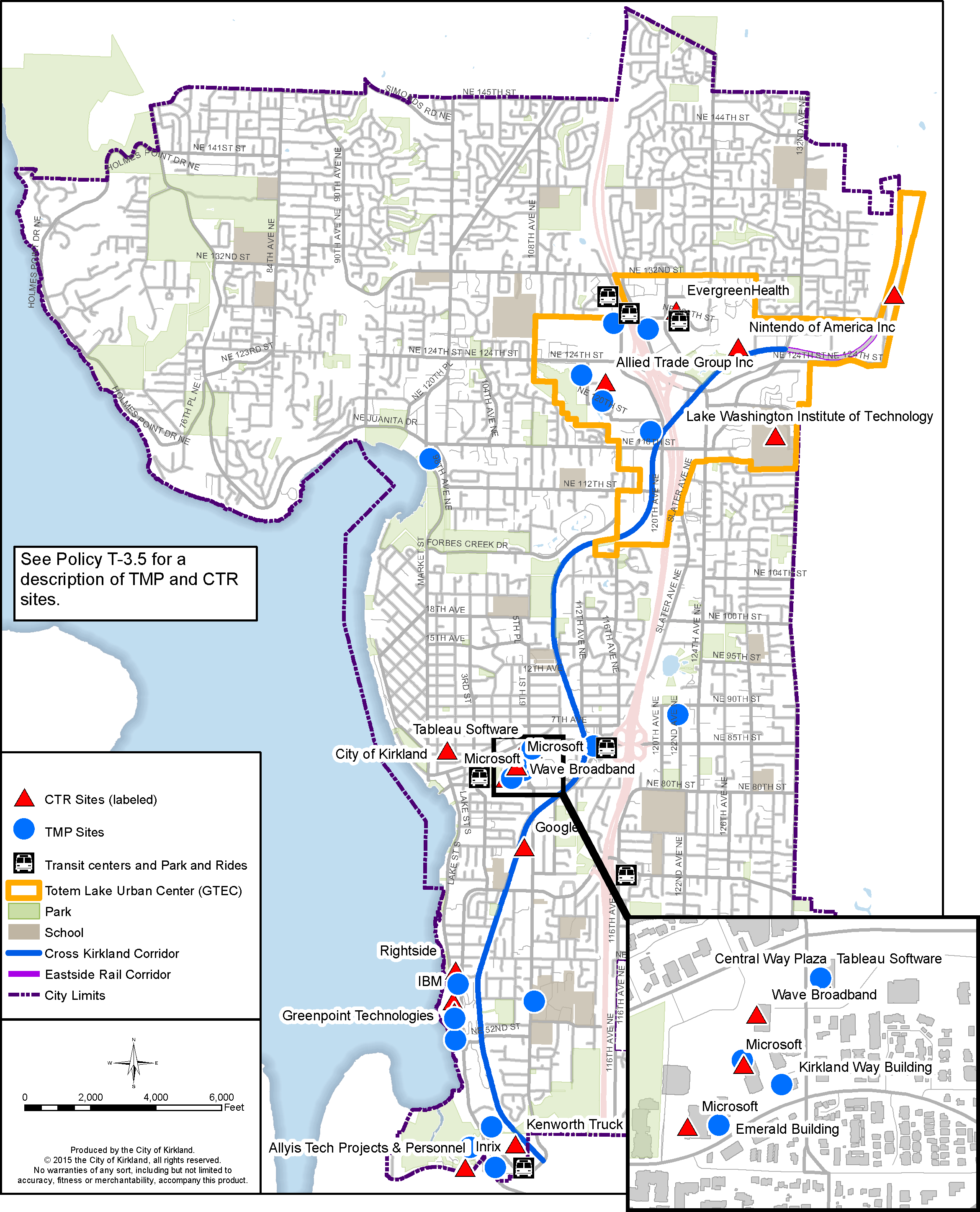4. PUBLIC TRANSPORTATION
Goal T-3: Support and promote a transit system that is recognized as a high value option for many trips.
Background
Historically, transit in Kirkland focused on connections oriented to Seattle in the morning and from Seattle in the afternoon. Bus frequencies were sometimes as low as one hour, especially in off-peak periods. Today, Kirkland is served by a number of routes connecting to a variety of Eastside destinations as well as Seattle. Frequency on some routes is 15 minutes, with most service at 30-minute intervals over most of the system. Additionally, instead of being solely a source for trips to employment centers, Kirkland is becoming an employment center that attracts transit trips.
Transit with the right characteristics can make an important contribution to Kirkland’s transportation system. At its best, transit is as follows:
Fast – making long trips competitive and cost effective with driving.
Frequent – frequencies of 15 minutes or less with service hours extending from early morning to late night.
Reliable – trip times are consistent from day to day and riders trust they will arrive on time.
Accessible – facilities and vehicles are designed for all users.
Comfortable – all elements of the system are sized to meet demand and offer amenities that make trips pleasant.
Complete – popular destinations are served and transfers between routes are easy and clear.
Transit providers will continue to be faced with constrained resources for maintaining existing service hours, limiting their ability to add new service. This, combined with the characteristics described above, suggests that Kirkland’s transit needs will best be served by a focused network of higher frequency service near major concentrations of residential and commercial land uses.
This transportation element challenges the idea that because Kirkland does not provide transit service, it has little effect on the quality of that service. Because transit, more than any other mode, is dependent on land use for success, Kirkland’s land use choices will have an important influence on where and how transit service is deployed.
Kirkland is, of course, responsible for maintaining the streets on which transit travels. Additionally, Kirkland can make improvements to waiting areas, including improved lighting, more shelters and wayfinding that is more understandable. Parking policy – such as pay parking at destinations – that is favorable to transit and projects that increase transit speed and frequency are other ways that Kirkland can support good transit.
In the future, Sound Transit will have a greater service presence in Kirkland. This will be in the form of bus rapid transit on I-405 in the near term, which will connect to the Totem Lake Urban Center and the Greater Downtown Urban Center. Additionally, transit has been assumed as an element throughout the planning of the Cross Kirkland Corridor and Sound Transit holds a transit easement on the Corridor. Regardless of where Sound Transit provides service in the long term, walking, biking and local transit connections to the regional transit system are paramount for its success.
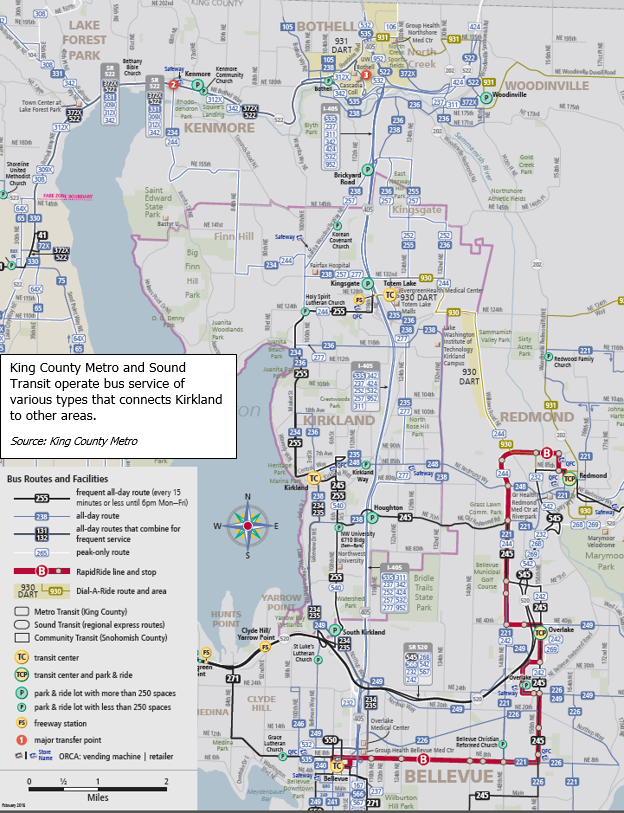
Transit station area neighborhoods, such as Totem Lake and Downtown Kirkland, will grow into thriving and equitable communities that bring opportunity for existing and new residents and businesses. The City of Kirkland will work as part of a coalition of jurisdictions, agencies, and nongovernmental partners to promote equitable transit communities near the region’s high-capacity transit investments. At the local level, we will continue to support policies and investments that make our station area neighborhoods safe, stable, and economically and socially vibrant places where people from diverse income levels can find opportunities to live and work.
|
|
The figure at left shows Sound Transit’s Long Range Plan. Projects from the Plan can become elements of a voter-approved plan. The Long Range Plan does not have a specific forecast year, nor is it financially constrained. Connecting the Totem Lake Urban Center to the regional transit system was Kirkland’s main interest in the latest plan update. The Long Range Plan includes possible connections via: the Eastside Rail corridor (including Cross Kirkland Corridor), I-405 and SR 522 with all four of Sound Transit’s modes: Light Rail, Commuter Rail, Bus Rapid Transit and Regional Express Bus. |
Figure T-22: Sound Transit Long Range Plan
Another opportunity to work with community partners will be to take the successful aspects of the transit-oriented development at the South Kirkland Park and Ride and explore implementing similar development at the Kingsgate and Houghton Park and Rides and at the remaining space at the South Kirkland Park and Ride. The transit system should be operated so that excess parking does not inappropriately impact neighborhoods.
Other modes of public transportation such as taxis and ridesharing can help fill gaps in transit service that are created when residents have mobility needs that traditional public transit cannot serve. Also, Kirkland should consider other forms of service provision such as partnering with the private sector, human service agencies and aggressive adoption of new technology that make sharing rides easier.
Kirkland is responsible for monitoring and encouraging the efforts of Washington State’s Commute Trip Reduction Program and its affected employers located in the City.
Policy T-3.1: Plan and construct an environment supportive of frequent and reliable transit service in Kirkland.
A Kirkland Transit Plan should be created and maintained that coordinates and describes in detail actions needed to meet the policies in this goal.
Transit operates primarily on facilities owned and operated by the City of Kirkland. Kirkland should make improvements that increase the speed and reliability of transit in order to attract more riders to the service. These improvements could include Intelligent Transportation System elements such as signal priority or more significant projects such as separate lanes for transit. In return for these improvements, transit providers should agree to maintain high frequency transit service.
Improvements should be prioritized by their ability to decrease rider hours spent delayed in traffic, and effects on other street traffic.
In areas that do not lend themselves to productive service by standard transit modes, innovative solutions should be examined with the intent of providing coverage at a reasonable cost. This could include direct investment by the City in transit service.
Ideally, transit riders should not drive an auto as a part of their trips. Every effort should be made to make walking and bicycling integral components of travel to the transit site. Such efforts may include making bicycle storage available at transit stops. Transit riders should not be prohibited from using on-street parking, near where they board, but there may be cases where impacts of on-street parking need to be managed.
The need for high quality transit service is also discussed in Goal T-7, Active Partnerships.
Figure T-23: Transit Delay in Kirkland (2014)
Policy T-3.2: Support safe and comfortable passenger facilities.
Passenger facilities must be clean, well lit, accessible to all and comfortable. The location of stops should be coordinated with adjacent land use. Bus arrival information and the ability to pay fares before boarding are examples of features that should be available. Improvements should be prioritized first to higher ridership stops served by higher frequency, longer span service.
Policy T-3.3: Integrate transit facilities with pedestrian and bicycle networks.
Ideally people can walk or bike to transit facilities. Making this possible requires the construction of pedestrian walkways and crosswalks and bicycle facilities so that people can walk and bike to transit, particularly when transit is on arterial streets. The City should work with transit providers to locate bus stops at areas that facilitate walking and biking to transit. A quarter of a mile (about 1,200 feet or about a five-minute walk) is considered a maximum distance for a convenient walk trip to transit. Transit facilities must be accessible to all users. (See Policy T-1.3.) A great resource for transit integration is the Cross Kirkland Corridor (CKC). The CKC provides a particularly critical multimodal transportation corridor, for future use by pedestrians, bicycles and transit.
Policy T-3.4: Support Transportation Demand Management (TDM) in Kirkland particularly at the work sites of large employers and other locations as appropriate in order to meet adopted goals for non-drive alone trips.
Kirkland has a number of employers that fall under the requirements of Washington’s Commute Reduction (CTR) Law and has established goals for several measures such as vehicle miles of travel and drive alone trips for these employers. Additionally the City of Kirkland is required to set a goal for the aggregate performance of CTR sites. Both of the goals are established in the City’s CTR Plan and must be within the framework established by the CTR Law. The current goals are as follows:
|
Performance Goals for Individual CTR Employers |
|
|---|---|
|
Measure |
2020 Goal for change from baseline* |
|
Non Drive Alone Trips |
+18.0% |
|
Vehicle Miles of Travel |
-18.0% |
|
Greenhouse Gas Emissions |
|
*2008 or first year of CTR survey, whichever comes later
|
Performance Goals for TLUC GTEC |
|
|---|---|
|
Measure |
Goal |
|
Non Drive Alone Trips |
55% |
|
Vehicle Miles of Travel |
-28.0% |
|
Greenhouse Gas Emissions |
|
These goals have been approved by the State Department of Transportation. The ability of a particular worksite to meet goals is influenced primarily by the resources provided by the employer. However, Kirkland should encourage and support these employers by providing tools and resources to support Transportation Demand Management in general and CTR employers in particular. The City is responsible for annually monitoring and reporting results.
The City Council has designated the Totem Lake Urban Center as a Growth and Transportation Efficiency Center (GTEC) as described in Washington State Law. The Totem Lake GTEC is required to have separate goals for performance above and beyond the CTR goals. These goals are established in the Totem Lake GTEC Plan.
There is room for innovation in order to significantly improve ridesharing, and innovations should be made, whether it be new ways of helping people find ridesharing partners, allowing new kinds of taxi-like services or other measures. Given the relatively small numbers of vanpools serving Kirkland employers, an opportunity exists to increase their number. The City’s CTR Plan provides further details on CTR and TDM plans.
Kirkland may be able to more easily meet its transit goals if its control over transit funding was broadened. This idea is explored further in Goal T-7: Be an Active Partner. Because the cost of fuel and drivers make up a high fixed cost of the transit system, automated vehicles and alternative fuels may be helpful in making transit service more affordable and therefore should be pursued.
Programs that support ridesharing should be results focused and cost effective. Grant funding should be sought for the bulk of program costs and partnering with transit and other agencies should be promoted.
Policy T-3.5: Require new developments to establish appropriate Transportation Demand Management Plans.
If the vision of the Transportation Element is to be met, developers and property owners will have to establish Transportation Management Plan (TMP) sites at the direction of the City. Transportation Management Plans are required at sites where, for example, there may be several employers, none of which by themselves are affected by CTR law, but together constitute a sizeable population of employees. TMPs may have a wide set of requirements that need to be enforced by the City; from basic requirements such as providing transit passes up to a cap on the number of trips a site can generate. These sites also need monitoring and support by the City if they are to meet performance goals for trip reduction.
Policy T-3.6: Pursue transit on the Cross Kirkland Corridor.
The vision for the Cross Kirkland Corridor includes quiet, low or no emission transit. This could be regional level light rail or more local service that connects to regional service, for example to Bellevue. New types of transit should be considered where they offer advantages to more standard modes. Appropriate transit on the CKC may well be something for which the City must lead the way as opposed to waiting for traditional transit providers to act. Heavy rail is not a mode that meets Kirkland’s interests for transit on the CKC.
|
Transit on the Cross Kirkland Corridor |
|
|
Transit on the Cross Kirkland Corridor is an integral part of the Master Plan. As the cross-section below shows, the corridor is wide enough to simultaneously accommodate excellent bicycle and pedestrian facilities, utilities and transit. |
|
|
|
|
|
|
|
|
|
|
|
Source: City of Kirkland, University of West Virginia |
|
|
The best mode of transit for the CKC is yet to be identified. Creative, forward thinking ideas should be used as inspiration for this decision. |
|
Policy T-3.7: Work with Sound Transit to incorporate investments in Kirkland. (See coordination policy T-7.1.)
Policy T-3.8: Partner with transit providers to coordinate land use and transit service. (See partner policy T-7.2.)
Figure T-24: Commute Trip Reduction and Transportation Management Plan Sites



